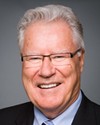Mr. Chairman, ladies and gentlemen, thank you and good afternoon. Thank you also for the chance to present a short overview of the Saab Gripen next-generation fighter.
My name is Tony Ogilvy. I look after international marketing for Saab aeronautics. My colleague is Mr. Peter Ringh, who is a technical director on the Gripen program. Mr. Patrick Palmer runs our Saab operation here in Ottawa as the executive vice-president for all operations.
By way of introduction, Saab is well established here in Canada. We have key technologies in service in the Canadian army, navy, coast guard, air force, and universities. The Gripen is in service in five nations and has flown over 1,400 flight hours. We are active in many competitive fleet replacement programs all around the world, most notably in India and Brazil. The aircraft itself is a multi-role fighter. It is super-cruise-capable and combines exceptional range of endurance un-refueled, with the most powerful close- and long-range missile armament in service today. It operates from very short strips. It needs only 800 metres of virtually any available surface to allow maximum payload operations. No other fighter can do this. Also designed into the aircraft is on-demand maintenance. Basically, if it is working, we leave it.
Turning to the capabilities, from the high-level mandatory documentation we have seen, Gripen, in our opinion, will meet and in many cases exceed all operational requirements of the Canadian air force in all roles by day and night. With regard to range and endurance, Gripen can fly farther and stay airborne longer than any of our competitors' aircraft. As an example, un-refueled, it has a range of 4,000 kilometres. That's from Goose Bay to Inuvik. On full alert, the aircraft can be airborne in less than 60 seconds. A turnaround in the field in air-to-air role will take just under ten minutes. And a hot-engine change in the field takes less than an hour.
Gripen is fully operational within NATO, and fully interoperable with our NATO allies. As to Arctic operations, the Swedish air force operates one of its three Gripen wings in a location farther north than Alaska, so we are well versed in extremes of temperature, because we have operational aircraft in service in all climatic zones worldwide.
Turning to weapons, Gripen next-generation has ten external store stations. It is capable of carrying a payload of eight tonnes and a wide range of short- and long-range precision weapons with full NATO interoperability. We will, however, integrate any weapon that you require. If we can carry it, we'll integrate it. It is currently the only aircraft in the world that can carry and fire the most powerful beyond-visual-range missile currently in service, the Meteor, and that is a testament to the level of technical superiority of our latest software standard.
We employ a balanced survivability concept with very low audio, visual, radar, and infrared signatures, plus an extensive suite of on-board integrated defensive aids. Gripen has for decades matured a highly sophisticated interflight data link that complements the wide-picture information incoming from Link 16. This local data link allows Gripen to share total situation awareness while operating in emission silence, which greatly enhances survivability and maximizes the chances of full mission success.
Future growth is built into the design concept. Gripen is designed to meet the demands of all future threat scenarios, and to remain in active operational service for 8,000 flight hours, which, at an annual flying rate of 170 hours a year, is about 40 years of service.
With the current procurement schedule, Saab can confirm deliveries to Canada of the Gripen NG in 2016.
Much is made of fighter aircraft generations. What is fourth, what is fifth, what is four and a half? In our view, if a fighter is equipped with the latest AESA radar and has total sensor fusion and the ability to distribute the data as needed to pilots and to off-board agencies, if it has a balanced survivability concept through very low signature management and is super-cruise-capable, that's a fifth-generation aircraft. And that's what Gripen NG is.
Now I'd like to briefly outline our pricing and key cost data for you. These figures are approximate and are based on in-year Canadian dollars. The acquisition price of one Gripen, the fly-away price, is about $55 million. That depends on configuration, but that's a real number.
The other critical financial issue for any nation operating this aircraft is the cost per flight hour over the aircraft's full life cycle of about 40 years, the in-service support cost. The figure we use is not produced by Saab but comes from a wholly independent source, the Swedish air force, which monitors very precisely all of the criteria to come up with the in-service cost figure. The in-service cost per flight hour for Gripen is between $4,000 and $4,500 in Canadian dollars. So for a full fleet of 65 Gripen NG, the cost per year would be between $44 million and $50 million Canadian for a full fleet of 65 aircraft.
If you take round figures, in terms of acquisition and in-service costs, a fleet of 65 Gripen NG will cost you just under $6 billion Canadian. That's about $3.75 billion Canadian to acquire the aircraft, and $2 billion to operate them over 40 years, or just under $6 billion for the whole package for life.
In the wake of the recent global financial crises, we all know that most nations are now moving to adapt to new economic realities, particularly in the mature western economies. We see this first-hand in our export markets. We see it all the time as many countries rapidly overhaul their procurement strategies. For many of the countries I work in, traditional defence procurement is a thing of the past. It's into this new environment that we believe Gripen NG can offer exceptional capability at minimum cost.
We also recognize that Canada is very closely involved as an export customer in the JSF program. Now, we obviously wish to enter a full and open competition to meet 100% of the requirement for the future Canadian air force, i.e., for all 65 aircraft. Should this prove too complex, we would offer for consideration a fighter fleet of JSF and Gripen, as an option. I can assure all those who balk at this proposal that Gripen has an extremely low support footprint, which would require minimal change to existing Hornet facilities. Further, the Gripen can integrate fully with the F-35. After all, that is what NATO has striven to achieve with its allies.
Such a combined fleet would provide for a balanced and very highly capable air force, a very formidable defensive and offensive mix, a strategic strike fighter in the F-35 and a tactical multi-role fighter in Gripen NG. Gripen would be able to fully exploit the extreme range of the Meteor missile to maximum effect in the defence of Canada's vast airspace and Arctic regions. Gripen would also be available to conduct those operations where JSF is not best suited and where the command would simply not wish to commit. Close air support of troops in the field is a classic example where a highly manoeuvrable and very agile fighter like Gripen is far more suited than the heavier and more cumbersome F-35 strike aircraft.
The two-seat version of Gripen is a fully operational aircraft and is well suited to additional roles, such as tactical formation lead in intensive high-threat environments and long-range search and rescue. With in-flight refueling, the aircraft will stay airborne as long as the pilot can stay awake.
In addition to the huge and real cost savings it offers Canada, Gripen will bring very significant and tangible benefits to the Canadian industrial base through full technology transfer and long-term development in partnership with Swedish companies in the defence sector and, if required, the non-defence sector, through the investor group. We offer full offset through the mutually beneficial industrial cooperation IRB program, and we have an unrivalled record in delivering what we commit to—and on time.
Companies may offer the transfer of technology when they actually mean a build or assembly process where the transfer of technology is actually minimal. Saab will transfer all—and we mean all—technologies required by Canada, including all source, single first-line code data. This will enable full national and functional control to be exercised over every element of the aircraft's offensive and defensive systems now and in the future.
We own those technologies in Saab systems. We give them to you and we give you every possible assistance in terms of software, support code, and transfer code to enable you to do the job yourself. We feel it's essential for Canada to have total control of the key software technologies, such as electronic counter-measures, your threat library, etc. Only you can have those controls--nobody else.
The transfer we offer will be hands-on, to fully enable Canada to build on its outstanding national capabilities in software development, which you already have in this country, and to fully enable sustainable engineering to be conducted here in country so you can update your aircraft to your own requirements. We would back and fully support all of these ventures from Sweden, as you require. We have this model under way in South Africa, where they run their own software, and have achieved great success in precisely this development program.
Saab recognizes and supports solutions for Canada that provide a manageable and reliable acquisition, long-term sustainability and support in Canada, for Canada, by Canadians. We believe that the Gripen NG fighter, in service with the Canadian air force, would significantly strengthen Canada's independent capacity to defend national sovereignty and security, provide exceptional industrial benefits and real technology transfer, and save you billions of dollars--and we mean billions.
We would also like to invite all of you, ladies and gentlemen, to come to Linköping, our base in Sweden, and look at the aircraft. Take along a screwdriver, take a forensic look at what we're actually offering, and allow yourselves to make your own decisions on what you see. All we ask is for the chance to properly demonstrate our capability to Canada and the Canadian air force, through an open and competitive process.
Thank you.










